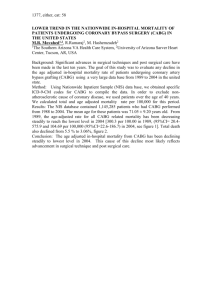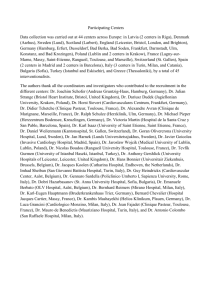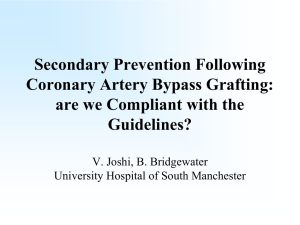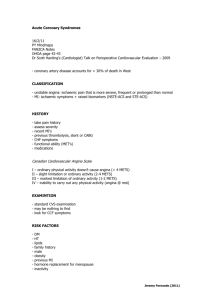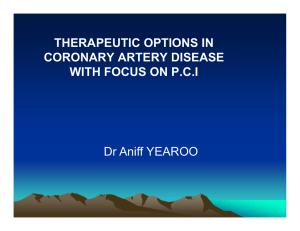A few basics of cardiac surgery…. Brett Sheridan, MD Assistant Professor
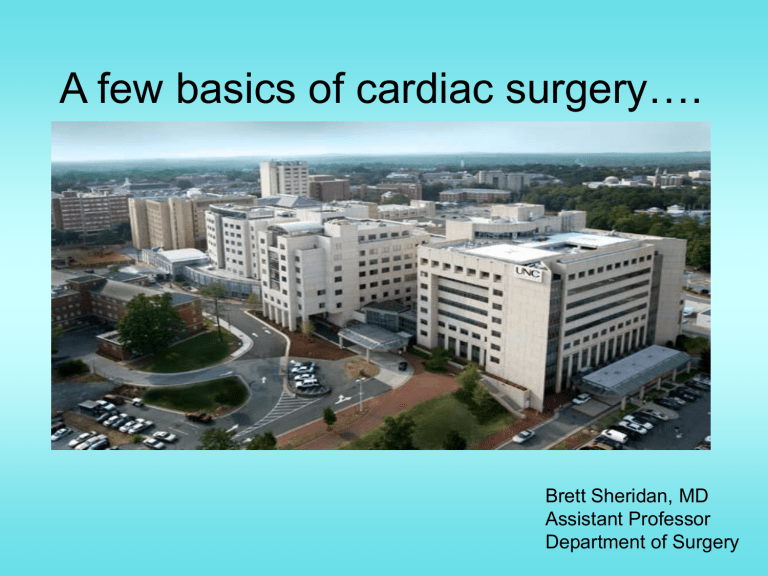
A few basics of cardiac surgery….
Brett Sheridan, MD
Assistant Professor
Department of Surgery
Define the difference between congenital and acquired (adult) heart disease.
What is the incidence of congenital heart disease in the Unites States?
List the 3 most common causes of death in the US…
1) Heart Disease
2) Cancer
3) Stroke
How many people in the US died from cardiovascular disease in 2001?
Do more men or women die from cardiovascular disease?
Define “acute coronary syndrome” according to the
American Heart Association
Acute coronary syndrome (ACS) is defined by EITHER acute myocardial infarction or unstable angina.
These patients are divided into 3 subsets:
ST elevation myocardial infarction (STEMI) non-ST elevation MI
Unstable angina
Describe the initial stabilizing treatment for symptomatic ischemic heart disease presenting in the ER
• ECG within 10 minutes
• Supplemental O2
• IV access continuous ECG monitoring
• Sublingual NTG if SBP > 90 mmHG
• Morphine
• ASA (chewed)
• Labs
• If ST elevation > 1mV or LBBB then reperfusion (fibrinolysis or PTCA)
What is AMI management in first 24 hours?
• Limited activity 12 hrs and monitor 24 hrs
• No prophylactic antiarrythmics
• IV heparin if:
– large anterior MI,
– PTCA, LV thrombus or
– thrombolytics administered
• SQ heparin for all others
• ASA indefinitely
• IV NTG x 24 hrs
• IV beta-blocker if stable
• ACE inhibitor if BP permits
• Statin therapy
What is a coronary angiogram and why do we do we perform them?
Percutaneous coronary angioplasty (PTCA, PCI,…)
What is a percutaneous coronary intervention (PCI)
Percutaneous coronary angioplasty
(PTCA, PCI,…)
Percutaneous coronary angioplasty
(PTCA, PCI,…)
Acute coronary Syndrome:
On-going myocardial ischemia despite initial Rx
Thrombolytics Revascularization
PCI CABG
Why are patients referred for CABG instead of undergoing a PCI approach to coronary artery disease?
I.e. which patients benefit from CABG?
Cite 2 prospective randomized trials comparing PCI vs CABG for the treatment of multivessel CAD
• Inclusion Criteria
– Symptomatic
– Multivessel CAD
– LVEF > 30%
• Baseline Characteristics
– Class III/IV angina - 66%
– Previous MI - 42%
– 3 vessel CAD - 30%
– mean LVEF = 60%
Comparison of Coronary-Artery Bypass Surgery and
Stenting for the Treatment of Multivessel Disease
(Arterial Revascularization Therapies Study Group)
Patients (n)
Late outcome
Death
MI
CVA
Revascularization *
Event-free survival *
Symptom-free *
Cost *
CABG
605
PCI
600
---------------------1 year-----------------
2.8% 2.5%
4.0%
2.0%
5.3%
1.5%
4 %
88%
90%
$13,638
17%
74%
79%
$10,665
Event –free Survival: CABG vs PCIS
14% benefit w/ CABG!
Risk of Repeat Revascularization
16 % benefit w/ CABG!
Risk of Death
3.7 % SURVIVAL benefit w/ CABG!
Conclusions-SoS Trial
• Again, repeat revascularization remains more common after PCI (with or without a stent) in multivessel CAD.
• In this study, higher rate of all cause mortality with PCI
Contrast the difference between
“off-pump” CABG versus the typical cardiopulmonary bypass supported
CABG
.
Traditional CABG
• General anesthetic
• Median sternotomy
• Conduit harvest (LITA, radial, vein)
• Institution of cardiopulmonary bypass
(CPB)
• Cardiac arrest
• Placement of aortocoronary grafts
• Separation from CPB
• Close
Advantages - Traditional CABG
• Still Heart
• Exposure and access
• Visualization
• The most intensely scrutinized procedure in US medicine
SAFETY
Disadvantages - Traditional
CABG
• Proinflammatory response to CPB
• Suggestion of end-organ injury
– CNS
– Pulmonary
– Renal
• Increased fluid shifts
Off-Pump Gear
Off-Pump Stabilizing Devices
Off-Pump Exposure of PDA
List 10 complications of CABG and there relative frequency
• Death
• Stroke
• Bleeding requiring re-op
• Wound Problems
• Myocardial infarction
• Arrhythmias
• Pneumonia
• Pneumothorax
• Cardiac Tamponade
• Pericardial Inflammation
• Renal Insufficiency
3%
1-2%
3-5%
0.5-5%
2-30%
10-60%
4%
1-2%
3-6%
18%
15-20%
What four medications prevent MI and death following a myocardial infarction?
• ASA
• Beta-blockers
• ACE inhibitor
• Statins
Class I
A prospective randomized trial comparing stenting with off-pump coronary surgery for high-grade stenosis in the proximal left anterior descending coronary artery: three-year follow-up
JACC, 2002, 40:(11) 1955-1960

